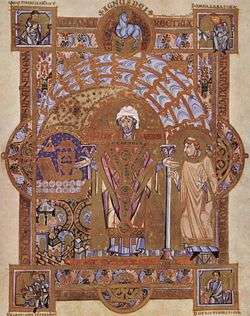Erhard of Regensburg
| Saint Erhard of Regensburg | |
|---|---|
|
Saint Erhard reads Mass | |
| Died | 7th century? |
| Venerated in | Roman Catholic Church |
| Canonized | 8 October 1052 by Pope Leo IX |
| Feast | 8 January |
Saint Erhard of Regensburg was bishop of Regensburg in the 7th century. He is identified with an Abbot Erhard of Ebersheimmunster mentioned in a Merovingian diploma of 684. Ancient documents call him also Erard and Herhard.
Life
According to the Catholic Encyclopedia, "the legendary account of his life offers little that is historically certain."[1] He was born in Ireland. Like many of his countrymen he went to the Continent as missionary bishop or chorepiscopus, and coming to the Vosges met there St. Hildulf, said to have been Archbishop of Trier, and who lived there as a hermit (666-671). He is called Erhard's brother, but very likely spiritual relationship was meant.
It is said that each of them founded seven monasteries. Thence Erhard went to Regensburg and founded the nunnery of Niedermünster. By Divine inspiration he was recalled to the Rhineland to baptize St. Odilia, blind from her birth, but who received her eyesight at her baptism. He sent a messenger to her father, Duke Attich, and reconciled him with his disowned daughter. According to another account, St. Odilia was baptized by Hildulf, Erhard acting as her sponsor. Theodo of Bavaria acted as Erhard's patron.
Death and burial

The year of his death is not known. He was interred in the still-extant Erhard-crypt at Niedermünster, and miracles were wrought at his grave, that was guarded in the Middle Ages by Erhardinonnen, a religious community of women who observed there a perpetual round of prayer.
Otto II, in 974, made donations of properties in the Danube valley to the convent "where the holy confessor Erhard rests". On 7 Oct 1052 the remains of the holy bishops Erhard and Saint Wolfgang were raised by Pope Leo IX in presence of Emperor Henry III and many bishops, a ceremony which was at that time equivalent to canonization. Regensburg documents, however, mention only the raising of Wolfgang, not that of Erhard.
At the close of the eleventh century, Paul von Bernried, a monk of Fulda, at the suggestion of Abbess Heilika of Niedermünster, wrote a life of Erhard and added a second book containing a number of miracles. The learned canon of Regensburg, Conrad of Megenberg (d. 1374), furnished a new edition of this work. The church in Niedermünster, now a parish church, still preserves the crosier of the saint, made of black buffalo-horn. A bone of his skull was enclosed in a precious receptacle in 1866 and is placed upon the heads of the faithful on his feast day, 8 January.
Three ancient Latin lives of the saint are found in the Acta Sanctorum (8 Jan). The beautiful reliquary is reproduced in Jakob, "Die Kunst im Dienste der Kirche" (illust. 16).
Trivia
• A beer brand from Bamberg, Germany is called St. ERHARD.
• Since Erhard of Regensburg was considered a patron saint for livestock, images of him were used as Schluckbildchen and given to sick animals in the German folk medicine during the eighteenth, nineteenth and the beginning of the twentieth century.
References
- ↑
 Herbermann, Charles, ed. (1909). "St. Erhard of Ratisbon". Catholic Encyclopedia. 5. New York: Robert Appleton Company.
Herbermann, Charles, ed. (1909). "St. Erhard of Ratisbon". Catholic Encyclopedia. 5. New York: Robert Appleton Company.
- Attribution
![]() This article incorporates text from a publication now in the public domain: Herbermann, Charles, ed. (1909). "St. Erhard of Ratisbon". Catholic Encyclopedia. 5. New York: Robert Appleton.
This article incorporates text from a publication now in the public domain: Herbermann, Charles, ed. (1909). "St. Erhard of Ratisbon". Catholic Encyclopedia. 5. New York: Robert Appleton.
